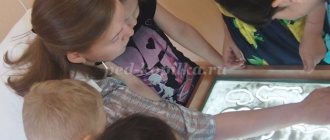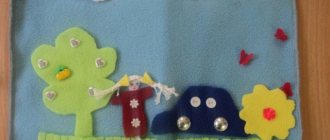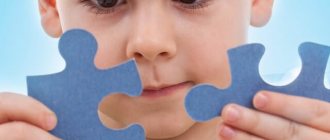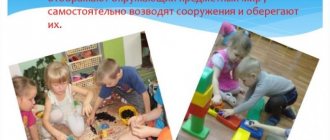How does this happen
The development of cognitive processes in preschool children is subject to a number of patterns.
The child begins not only to contemplate the objects around him, but begins to show a keen interest in them. He begins to understand that every thing has size, shape, color and many other distinctive features; they feel different to the touch and have different temperatures. Over time, in addition to vision and touch, the child begins to develop hearing. He gradually learns to identify and compare sounds by volume.
The first stage is the development of sensory cognition
Gradually, the child begins to regulate sensory processes by looking at something or listening to something. Attention and perception develop; sensory processes become more conscious.
However, the development of cognitive processes, both at younger and older ages in preschoolers, is still far from perfect. For example, it has been noticed that children do not immediately begin to understand perspective, as well as other spatial relationships. Difficulty perceiving time.
Let's consider how exactly the cognitive processes of preschoolers should develop, and how a parent can help a child master the complex, but amazing and mysterious world around him.
Attention in preschool age
It is worth noting that the attention of preschoolers is still involuntary. The child distinguishes objects from the total mass depending on their brightness, contrast, and difference from the main background. And only later does it acquire the features of intentionality. The parent begins to notice that the child prefers to strictly observe certain objects on which his activity is directed. Now he sees not only what is catchy, new and bright, but what is of interest to him.
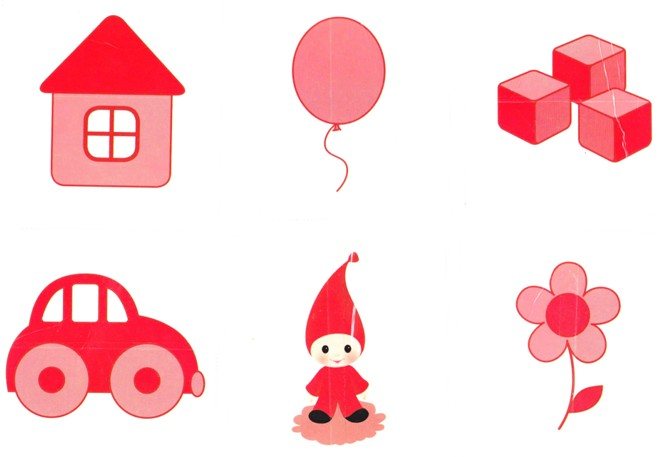
Test for knowledge of names of objects
Despite the fact that in the preschool period the development and improvement of both involuntary and voluntary attention occurs, the main emphasis should be placed on the development of the second.
In order to teach a child to highlight the significant, “pushing” the less significant into the background, it is necessary to take into account the following.
- For the development of voluntary attention, it is necessary that the child’s activity be directed. That is, when starting to carry out this or that activity, he must have a fairly clear idea of the desired result. This will allow the child to keep his attention on it and control distractions in the process.
- Considering that at first it will be difficult for a child to carry out directed activities independently, at first he will need fairly simple, but clear and detailed instructions from an adult. Thanks to this, he will be able to get an idea not only of the goal, but also of the ways to achieve it. It is most desirable that the stages on the way to achieving it - small tasks and their results - be presented clearly. For example, when asking a child to do some kind of craft, it is best to do it with him, showing preliminary results and allowing the child to compare what he did with the standard. This will keep the child’s attention for a long time and keep it until the very end.
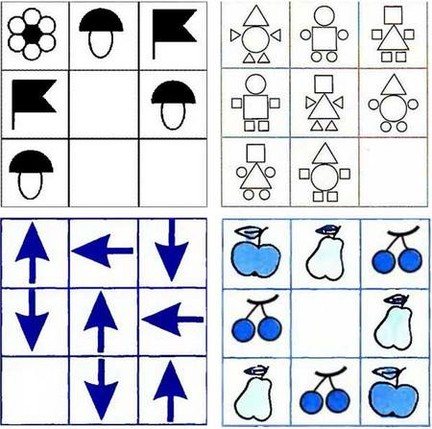
Attentiveness test for 6-year-old children - Voluntary attention of preschoolers develops on the basis of involuntary attention. That is why the objects that children will deal with during classes should be bright, unusual, novel, or of interest to him.
Memory development in preschool age
A kind of “starting point” for the development of voluntary memory in a child is considered to be the age of three years. It is from this period that most people begin to remember events related to their lives. However, memory in preschool age also has its own distinctive features. Firstly, like many other cognitive processes at this stage, it is involuntary. The child cannot yet control it, and memorization obeys a simple law: of all the stimuli affecting the child, only one, but the strongest, is remembered. Secondly, the child’s memory is situational in nature - when remembering something, the child can mention the circumstances accompanying the memorization process.
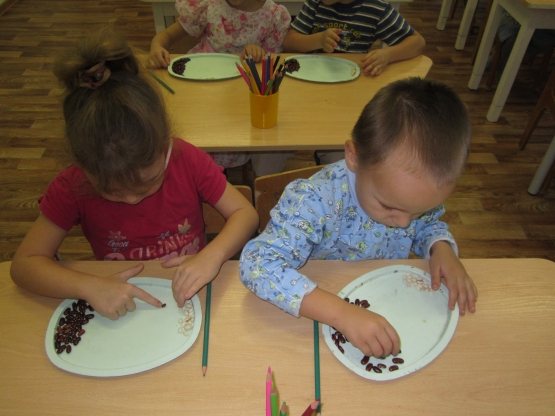
Development of attentiveness and motor skills in the game
It is involuntary memorization that has the most significant impact on the child’s activities.
However, the features of the development of cognitive memory processes in preschoolers are already beginning to be distinguished by the following features:
- Isolating the object of memorization from the memorization situation itself
- Using reliance on the sequence of events and building simple logical connections.
- Strength of memory and the ability to retain information in memory for a certain time.
- Using the simplest elements of voluntary memorization.

Just like for developing any other processes, first you need to use bright, contrasting objects. And also gradually move from visual objects to the perception of memorized material by ear. Excellent tools for the development of auditory memory in the preschool period are learning short children's poems and retelling the plot of favorite fairy tales.
Towards the end of preschool childhood, the child begins to show the rudiments of logical memory, which is built on the child’s understanding of the connections that exist between objects and phenomena. Now the child can remember larger amounts of information and more effectively apply the experience gained in practice.
Imagination in the preschool period
Despite the fact that children are always distinguished by a bright, developed imagination, this ability to process and recombine existing information does not come to them immediately.
At the very beginning of its development, imagination is built on joint work with the parent. And only then it is transformed into a process carried out on the basis of speech without the need to carry out any physical actions.
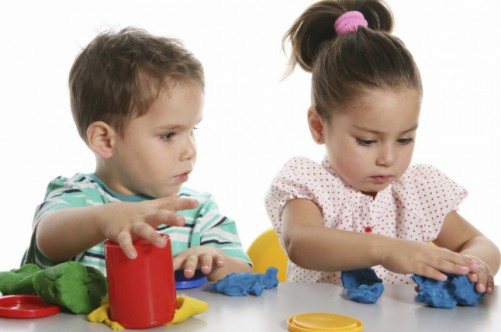
Modeling with plasticine develops imagination
In order for the imagination to be formed as effectively as possible, it is advisable for an adult to complement the images created by the child with specific details, giving them completeness. Then the child begins to “complete” the elements independently, combining the disparate elements of the picture into a single whole. And, perceiving information by ear, he learns to present it in the form of a visual, sensory or any other image. The child learns objectification and substitution. This feature of preschoolers is especially evident in story games, where, for example, a stick, depending on the conditions, can easily begin to be used both as a spoon for a doll and as a pistol. The child also begins to actively use schematization and detailing, coming up with all sorts of actions and functions, both for objects and their substitutes.
Schematization is expressed in the transfer of already familiar patterns of actions learned by the child to qualitatively new conditions. Detailing is manifested in the desire to supplement each action with new lines and voice intonations. The same plot can be played out differently in new conditions.
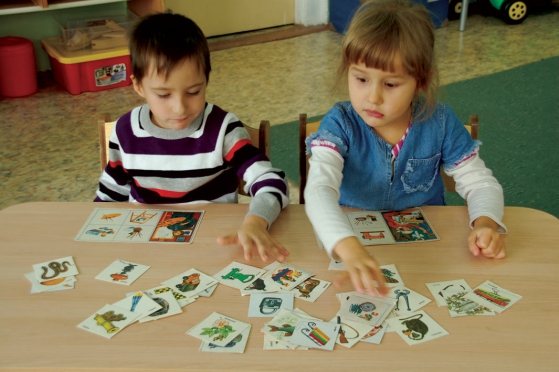
As we have already mentioned, the imagination of preschoolers already has a verbal form. Often this leads to the formation of a tendency to lies and fears: moving away from reality as much as possible, the child not only begins to create a new reality, but also to believe in it. However, at the age of 5 years, he already begins to clearly distinguish reality from fiction. Imaginary plots begin to be built on a certain logic and, over time, become as close to reality as possible. Attempts to build cause-and-effect relationships are traced. Realizing that he can easily be caught in a lie, the child begins to avoid it and understand what its harm is.
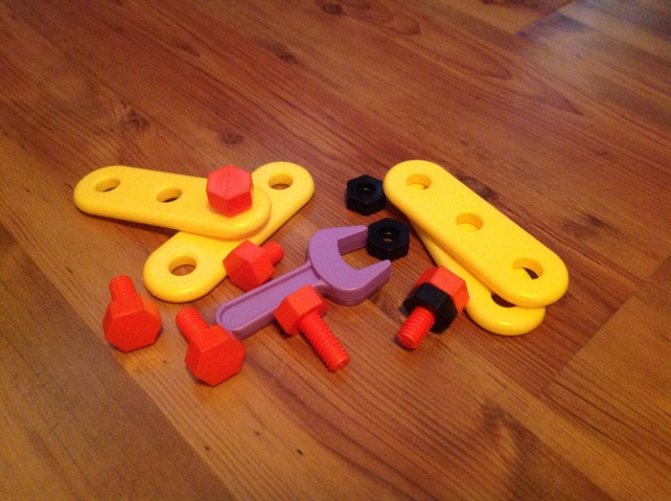
A great way to develop imagination is a construction set
Thanks to imagination, the child has the opportunity to experience new sensations, gain ground for self-expression and self-realization. It is on this feature that cognitive, creative, and play activities will be built in the future.
Until about 6 years of age, imagination is largely involuntary. The imagination acquires features of arbitrariness in older preschool age.
The structure of the cognitive sphere and a brief description of the development of processes
Cognitive processes form the basis of the cognitive sphere. These include:
- perception;
- imagination;
- memory;
- thinking;
- attention.
They are all so closely intertwined that in the same short period of time they are all involved, instantly switching from one to another.
The last of the listed mental processes has a special function - it acts as a kind of regulator and determines which object will be processed in the brain center. The child pays attention to an object or its detail, to a natural phenomenon or sound, and at the same second he identifies something, remembers it, imagines it, thinks it over.
It stands out for its specific weight in the cognitive sphere and perception. This is the leading cognitive process in preschool age, since mental development begins with the receipt of sensory information through the senses. Gradually, perception acquires meaning and becomes the basis of cognitive activity. From this same process, memory is split off and acquires independent functions of cognition.
Perception
The process of a child's mental development is triggered by perception. Through manipulation of objects and sensory organs, sensory information enters the child's brain. The baby sees colorful figures, touches soft toys, tastes a plastic ring... Consequently, visual and tactile perception are actively involved.
The received sensations are accumulated and stored for further use as sensory standards.
The development of sensation and perception every year leads the preschooler to important achievements:
- identifying the most important signs based on an examination of surrounding objects;
- formation of sensory standards and mastery of their use;
- formation of spatial orientation, concepts of depth, height, etc.;
- perception of time and orientation in time intervals,
- ability to perceive works of art.
By the age of 3, a child already has a certain information base that allows him to recognize, remember, and perceive more complex phenomena and holistic objects.
The youngest preschooler is still examining objects randomly - in the game, the most catchy qualities. But already at the age of 5, a child is able to closely examine a certain object in order to learn as much as possible about it, to identify its features and properties.
In older preschool age, intellectualization of perception occurs. The preschooler sets the task of examining an object or determining its qualities. If necessary, he gives a verbal description of what is perceived with the necessary detail.
Memory
During preschool childhood, a huge amount of information is accumulated and processed. Memory helps to cope with this. A preschooler develops the following types of memory:
- figurative;
- motor;
- verbal.
The first memories are fragmentary, in the form of single ideas about a specific subject. But these discrete representations already allow the child to remember and recognize previously seen objects or familiar people.
Younger preschoolers are focused on the most noticeable signs, and they remember them. More often than not, these signs are not significant. It doesn't matter at all that the ball is red. The main thing is that he is resilient and can jump.
But the ability to analyze at the age of three is still in its infancy, and the child can persistently choose the red ball with which he has already played.
First of all, a preschooler develops figurative memory. While playing with toys or examining an object, he notices more and more characteristics, thanks to which an image is formed. An adult provides significant assistance in the development of a child’s figurative memory if he draws his attention to important signs and pronounces: for example, a teapot has a spout, a flower has petals.
Older preschoolers themselves use speech to better remember information. The figurative type of memory is complemented by the verbal one. Firstly, children learn more and more words, and secondly, they associate a word with an image, moving both one and the other to the corresponding parts of the brain.
The preschooler gradually supplements direct emotional memorization and subsequent recall with voluntary use of memory using verbal form. He learns to subordinate his actions to certain goals. In the same way, he sets himself the task of remembering the story or the order of assembling the construction set in order to reproduce it if necessary.
In older preschool age, voluntary memorization is formed and logical memory is activated, which contributes to the development of other cognitive processes.
Imagination
The mental process of imagination begins to develop at a time when at least a minimal stock of concepts and images accumulates in memory. The simplest use of a small hoop as a steering wheel requires the child to remember the car and have a figurative idea of how to handle this “steering wheel”.
In early preschool age, imagination is only reproductive in nature. The child remembers what he has already seen or heard, shows minimal imagination in order to select suitable substitute objects and use them in play activities.
Children's imagination changes qualitatively if a preschooler learns to supplement a familiar image or plot with new details. At the age of 5, children draw a candy tree and a fairyland, try on the images of wizards and fairies, and come up with role-playing game plots.
A six-year-old child boldly imagines. Can create a fictional character that only vaguely resembles a well-known image. The imagination of an older preschooler is characterized by the fact that he comes up with a plan, and then looks for a means to realize it: draw, sculpt, compose a story. The process of imagination becomes a creative activity.
Thinking
The formation of a preschooler’s thinking occurs through the dominant forms of cognition of reality. The child goes from practical actions to logical conclusions, using forms of thinking:
- clearly effective;
- visually figurative;
- verbal logical.
At the initial stage, the child’s mental activity is closely intertwined with his practical actions. By examining objects, the baby receives information about their properties. By learning to use household appliances, one not only learns their functions, but also receives a lot of additional information. Children draw certain conclusions when they see how the cup breaks, the paper tears, and the towel remains intact no matter how much you pull it.
Elementary actions provide a lot of information that is remembered and used by the child in mental operations. For example, when building a tower of cubes and cones, a child may try to place the cube on the cone, but after the first attempt he will be convinced that such a configuration is impossible and will begin to use the cones only as finishing details.
Visually imaginative thinking allows a preschooler to analyze, compare, and draw conclusions without resorting to action. The child begins to think on the basis of images at the stage when he forms generalized ideas about objects and phenomena.
By accumulating experience in games, creative activities, construction, and speech activities, older children begin to comprehend logic and objective laws. The prerequisites for the development of logical thinking are formed. At first, logical thinking manifests itself as thoughts out loud, often accompanying action. The child learns more and more concepts, expresses his judgments about what he observes or imagines. Verbal logical thinking develops as a transition to theoretical thinking. Gradually, reflections move to the internal plane, and the preschooler formulates a ready-made answer or proposal.
Methods of mental activity are mental operations. By the end of preschool age, analysis, comparison and generalization develop most.
Attention
The development of attention in preschoolers consists of expanding the volume and developing the most important properties:
- distribution;
- sustainability;
- switching
The youngest preschooler already manages to pay attention to two subjects at the same time. Especially if this process is controlled by an adult and offers to examine both objects at the same time (the apple is red-sided, and the pear is yellow; two cubes - large and small). The child needs to distribute his attention, and at first he manages to pay attention to only two objects.
At 3-4 years old, a child is able to do one thing for up to half an hour. But the stability of attention depends on the type of activity. He can look at a picture for no more than 5 minutes, while he can play for 20 minutes. Sustainability of attention increases significantly towards older preschool age and can be seen in activities that are attractive to the child.
The most difficult thing for a preschooler is voluntary switching of attention. Involuntarily, his attention can move from one object to another and linger just as long as interest exists. By the beginning of school, a child needs to learn to switch attention based on a signal. It is important to start such training from the age of 6, since this is a favorable age for the development of this property.
Attention accompanies the formation of all cognitive processes in preschoolers. It functions as a signal to trigger perception, imagination, thinking, and is also a condition that ensures the duration of the process.
In childhood, attention is involuntary, that is, for the most part it occurs unintentionally, based on the interest and cognitive activity of the preschooler. The task of adults is to guide the child, to train him to maintain attention, which will lead to voluntary control of the process.
The formation of thinking in preschool age
Children are inquisitive. Studying the world around them, they note its distinctive features and ask questions related to it. By observing cause-and-effect relationships, they begin to understand over time why certain events occur.
The main types of thinking that function in the period of preschool childhood are visual-effective, verbal-logical and figurative.
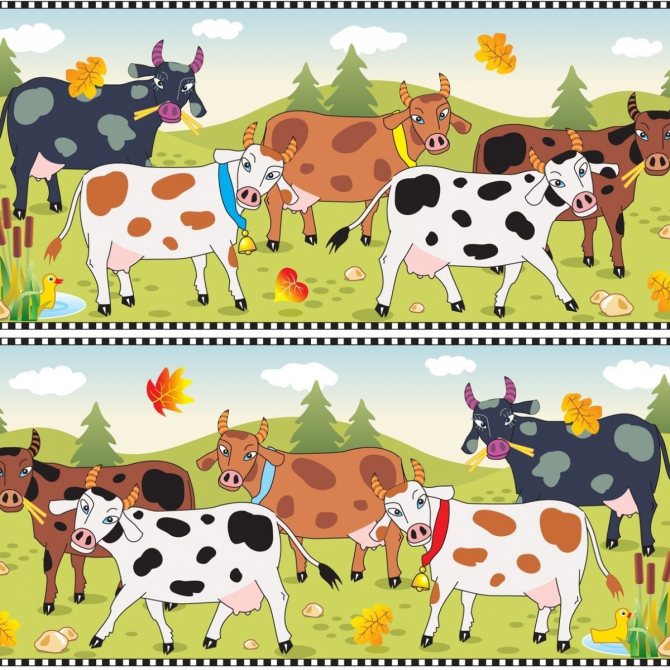
Test for attentiveness and level of thinking
Visual-effective thinking is used to solve problems that are performed using objects or tools. A clearly defined practical result is achieved, most often by trial and error. However, as the problem becomes more complex, solving it this way becomes impossible.
It is then that the child begins to develop imaginative thinking. It is necessary in cases where the situation goes somewhat beyond the child’s personal experience. However, conclusions are based on properties visible to the eye, and often do not obey not only logic, but even general grounds. And yet, it is on the basis of imaginative thinking that attempts at qualification and generalization are built; the child learns to perform simple operations. imaginative thinking also largely serves as the basis for intuition and experience. Then the child learns to use diagrams and learns the relationships between sizes, shapes and colors. He develops the rudiments of logical thinking, allowing him not only to solve problems, but also to explain how this happens.
But before this happens, the child will need to acquire the skill of working with both real available objects and their substitutes, or symbols, drawings, or just names. The child develops a conceptual apparatus that allows him to solve emerging problems without the use of objects and images that replace them.
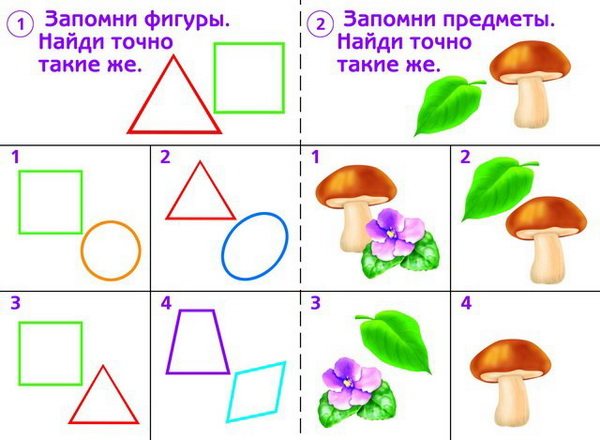
Mastering concepts occurs in the process of targeted learning. At the initial stages, work is done with a large number of visual aids. For example, when talking about the life of animals and birds, it is necessary to have pictures with you that illustrate different aspects of their life. And when learning basic arithmetic operations, it is best to perform them with chips or cards. Then the need to use them will disappear, and the child will perform all actions independently in his mind.
A good indicator of a child’s level of logical thinking is his ability to find and explain mistakes or absurdities, as well as his reactions to jokes.
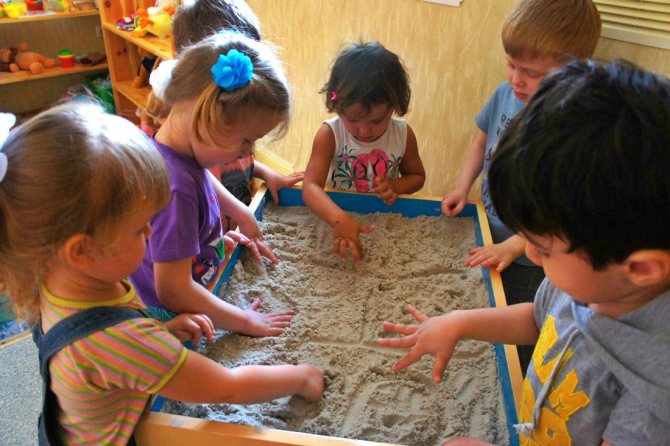
Playing with sand and small objects greatly helps develop thinking
These features also indicate the child’s intellectual readiness for school. An important role is also played by the child’s attempts to carry out his own cognitive activity, connecting and separating objects, observing the behavior of people or animals, and mixing substances.
Features of the development of cognitive abilities of children of senior preschool age 5–7 years
Popova Lyudmila Viktorovna
Features of the development of cognitive abilities of children of senior preschool age 5–7 years
Content
1. Introduction
2. The concept of “ cognitive process ”
3. Features of the formation of cognitive processes in children of senior preschool age.
4. Ways of a positive attitude towards cognition in children of senior preschool age
5. Conclusion
1. Introduction
One of the main directions of modernization of preschool education is “ the development of independence , curiosity and initiative of preschoolers in various types of activities” [1]
Preschool childhood is the period when the foundation of a future personality is laid. It is preschool childhood that is the period of initial knowledge of the surrounding reality. The development of a child in preschool age is associated with his abilities - those individual psychological characteristics of a person that ensure high achievements in any activity.
The mental development of a preschooler is the most important component of his overall mental development , preparation for school and for his entire future life - this is the process of forming cognitive interests , accumulating a variety of knowledge and skills, and mastering speech. As L.A. Wenger notes, the “core”
mental
development , its main content is the development of mental abilities . Mental abilities are those psychological qualities that determine the ease and speed of assimilation of new knowledge and skills, the possibility of using them to solve various problems. [2] The development of mental abilities is of particular importance for preparing children for school. After all, it is important not only what knowledge a child has by the time he enters school, but whether he is ready to acquire new knowledge, whether he can reason, think convincingly, guess, show mental effort, fantasize, draw independent conclusions, build ideas for essays, drawings, designs . All this presupposes a certain degree of formation of cognitive processes (memory, thinking, imagination, etc.)
.
2. The concept of “ cognitive process ”
Cognitive abilities are those qualities and personality traits on which successful mastery of any type of activity depends. They cover sensory, intellectual, creative abilities . Cognitive abilities refer to general abilities , i.e. they are used and developed in the process of mastering knowledge in various sections of educational programs. abilities by the following mental properties: quality of mind (breadth, depth, independence, initiative, flexibility, memory features (speed, accuracy of memorization, completeness of reproduction)
etc.
Cognitive processes (perception, memory, thinking, imagination, etc.)
are an integral part of any human activity that provide this or that information.
They allow a person to outline in advance goals, plans and the content of upcoming activities, play out in his mind the course of this activity, his actions, and manage them as they are completed. When they talk about a child’s mental abilities , they also mean and characteristic features of his cognitive processes , because the better are developed in a child, the more capable he is , the greater capabilities he has, the ease and the effectiveness of his teaching. A person is born with sufficiently developed inclinations for cognitive activity , but cognitive processes unconsciously, instinctively. He still has to develop his cognitive abilities and learn to manage them. Therefore, the level of development of a child’s cognitive abilities depends not only on the inclinations received at birth (although they play a fundamental role)
, but also on the nature of the child’s upbringing and education in the family, in kindergarten, and on his own activities for
the self-development of his intellectual abilities . Based on the above, it can be seen that a child’s learning ability depends mainly on the nature and degree of formation of cognitive processes , the term “learning ability”
should be understood as: mastery of mental activity techniques
(mental operations - analysis, synthesis, generalization, comparison, etc. .)
- mastery of activity techniques - in this case, play, since play is the leading activity in
preschool age (practical skills - completing a play task, the ability to build a game together with peers, how to choose the necessary toys or their substitutes, etc. ). The goal of education in kindergarten is for the child to master a certain range of knowledge and skills specified by the program. The development of mental abilities is achieved indirectly: in the process of acquiring knowledge. The mental education of a child, as A. N. Leontyev rightly emphasized, cannot be considered in isolation from mental development , from the wealth of interests, feelings of other traits that form his spiritual appearance. Preschool childhood is a very short period in a person’s life, only the first six to seven years. But they have lasting significance. During this period, development is more rapid and rapid than ever. From a completely helpless being who can do nothing, the baby turns into a relatively independent, active person. receive a certain development , thereby laying the foundation for further growth.
[3] 3. Features of the formation of cognitive processes in children of senior preschool age .
Thus, for an older preschooler features are noted (memory, attention, thinking, imagination)
:memory: involuntary figurative memory predominates;
becoming more and more united with speech and thinking, it acquires an intellectual character; verbal-semantic memory provides indirect cognition , expands the scope of cognitive activity; elements of voluntary memory are formed as the ability to regulate this process on the part of the adult, and then the child himself; the prerequisites are formed for transforming the memorization process into a special mental activity, for mastering the logical processes of memorization; as the child accumulates and generalizes experience with adults and peers, development is included in personality development ; is formed and developed - long-term memory; The memory capacity is significantly expanded; the ability to quickly and efficiently memorize material occurs development and formation of the basic properties of attention - voluntariness develops , the ability to voluntarily concentrate (concentrate)
on the material increases, the volume, distribution, and switchability of attention increases.
All of the named properties of attention become voluntary, that is, conscious and controlled and controlled by the child himself with a conscious goal. Sensations and perception: development (exacerbation)
of all properties of sensations occurs - quality, intensity, duration, spatial localization.
In his behavior, the child increasingly listens to his feelings and his behavior becomes in accordance with the feelings that he experiences about this or that fact of life; situational sensations can be arbitrary at the will of the child himself, that is, consciously and consciously, and he listens to them and builds his behavior with them. When perceiving the surrounding reality, the senior preschooler is guided by the increasingly developing properties of perception - objectivity of perception, integrity, constancy, structure. His perception becomes more and more meaningful, the ability for apperception , that is, the dependence of perception on the content of the child’s mental life, on the characteristics of his personality ; complex forms of perception (perception of space, time, movement, etc.)
continue
to develop and increasingly the child uses them as a guide in certain life situations. Imagination: arbitrary nature predominates, suggesting the creation of a plan, its planning and implementation; becomes a special activity - turning into fantasy; the child masters the techniques and means of creating images. Thinking: visual and figurative, the verbal and logical form develops thinking acquires the characteristic of being non-situational, i.e. the child solves mental problems in imagination; thinking becomes problematic, that is, the ability to independently analyze, synthesize, abstract, and establish cause-and-effect relationships develops and, as a result, the child solves the mental problem that arises in front of him; an understanding of the causality of phenomena arises, which is an indicator of the development of reasoning , which is a way of solving certain mental problems; a different attitude towards mental and practical activity is formed, when it arises on the basis of preliminary reasoning, increases ; preschool child moves from using ready-made connections and relationships to the “revelation”
of more complex ones;
attempts arise to explain phenomena and processes; experimentation arises as a way to help understand hidden connections and relationships, apply existing knowledge, try one’s strengths; the prerequisites for the qualities of the mind are formed: independence, flexibility, inquisitiveness. When considering the issue of the characteristics of cognitive development , i.e., the characteristics of the development and formation of cognitive processes , it is necessary to remember the close relationship and interdependence of thinking and speech. According to the theory of L. S. Vygotsky, there is a close connection between thinking and speech. Expanded speech is not only a means of communication, but also a tool of thinking. [4] 4. Ways of a positive attitude towards knowledge in children of senior preschool age
In the research of N. N. Poddyakov, two contradictory trends were discovered in the process of knowledge formation in children of preschool age . The first trend: there is an expansion and deepening of clear, clear knowledge about the world around us. This stable knowledge forms the core of the child’s cognitive sphere . The second tendency: in the process of mental activity, a circle of vague, not entirely clear knowledge appears and grows, appearing in the form of guesses, assumptions, questions. This developmental children’s mental activity . During the interaction of these trends, the uncertainty of knowledge decreases - it is clarified, clarified and turns into certain knowledge. [5]
Working with preschool , the teacher, forming a base of clear knowledge, at the same time ensures continuous growth and vague unclear knowledge. However: information (information, facts, life events)
is considered not as an end in itself, but as a means by which it is necessary
to develop cognitive needs and interests in a child.
A positive attitude is created in two ways.
The first way to create a positive attitude towards an activity is achieved by the formation of positive emotions (and then feelings)
in relation to the object of activity, to the process of activity, to the persons with whom the child deals;
this attitude is formed on the basis of the teacher’s expression of a positive attitude towards the child and the activity, acquaintance with excellent examples of activity, expression of faith in the strengths and capabilities of the child, approval, help and expression of a positive attitude towards the achieved results of his activity. From this point of view, success (given the feasible, surmountable difficulty of the task)
and its public assessment are of great importance. It is easier to create an emotional relationship if the new activity is at least partially related to previous interests.
The second way to create a positive conscious attitude towards activity lies through the formation of an understanding of the meaning of the activity, its personal and social significance. This understanding is achieved through a figurative story about the meaning of the activity, an accessible explanation and a demonstration of a significant result.
If nurturing interest is limited to creating a positive attitude, then engaging in an activity will be an expression of love or duty. the cognitive nature that is most essential for interest . With the slightest change in attitude, with the disappearance of attractive objects, the child loses the desire to engage in this activity. Interest arises only in the course of properly organized activities.
During preschool age, cognitive activity goes through a complex path of development from simple orientations caused by the novelty of the subject to the desire to resolve contradictions between acquired knowledge and skills that arose in the process of activity. The Federal State Educational Standard for Educational Education interprets this path “as a process of gradual transition from one stage of development of cognitive activity to another” [1]. These stages include[6]: 1. Curiosity, the manifestation of which at this stage is determined by a selective attitude towards any subject, due to external signs, sides and circumstances that are often suddenly revealed to the child. 2. Curiosity is characterized at this stage by an active vision of the world, manifested in the child’s desire to penetrate beyond what is seen and known . It is in preschool age that curiosity becomes a stable character trait and has significant value in the development of the personality as a whole . This stage is characterized by the manifestation of strong emotions: surprise, joy of learning , delight, satisfaction from activities.
Systematic active independent “search” activity and the accompanying experience of joy, knowledge and achievement form a persistent dynamic stereotype of cognitive interest , which gradually turns into a quality characterizing the personality.
Genuine interest, formed in the process of specially organized active independent “search” activity, is characterized not only by an emotionally positive attitude towards it and an understanding of the meaning and meaning of this activity. The main thing is that he is characterized by an emotional-cognitive attitude towards the process of this activity, which is internally motivated. This means that, in addition to personal and social motives outside of those required in relation to the activity, motives arise that come from the activity itself (the activity itself begins to motivate the child)
. At the same time, the child not only understands and accepts the goal of this activity, he not only wants to achieve the goal, but also wants to search, learn, decide, achieve.
In older preschool age, on the basis of the experience gained in educational, play and work activities, the prerequisites for developing motivation to achieve success are formed. The task of parents and teachers is to instill in a preschooler the desire to develop motivation to achieve success. This will allow the child to achieve success in life and grow up to be a happy and harmonious person.
Conclusion
The development of cognitive interest in preschoolers is possible only in the presence of a developmental environment .
Children are very susceptible to their surroundings and therefore the entire environment is of great developmental importance . With external passivity, surrounding objects actively influence children . In the process of interacting with objects of the surrounding world, children learn about the purpose of things, compare toys with each other, pay attention to their shape, size, color, material, proportions.
It is impossible to talk about the full development of a preschool child if his environment is primitive and chaotic, and he does not receive positive information from interacting with it. With the help of a developmental environment, you can change the activity of children , influence their emotional state, or you can interfere with the manifestation of imagination, the development of individuality , and negatively influence the relationships between children and the learning process. Therefore, we must strive to ensure that each item is an organic part of the developmental space and stimulates the activity of children (toys, including multifunctional ones, pencils, paper... are located in places accessible to children ).
An indicator of cognitive interest will be if children:
• Think (analyze, generalize, prove)
• They are surprised, rejoice at successes and achievements, novelty
• Attentive, persistent, strong-willed
• They fantasize (anticipate, create new images
Therefore, it can be assumed that cognitive activity is “initiated by the child and dictated by his internal state”
[7]
List of used literature:
1. Federal state educational standard for preschool education (adopted on October 17, 2013, entered into force on January 1, 2014)
2. Wenger L. A., Dyachenko O. M. “Games and exercises for the development of mental abilities in preschool children ” M., 1989
3. Leontyev A. N. “On the formation of abilities//Questions of psychology ”
1960 №1
4. Vygotsky L. S. “Thinking and Speech”
M.: Nauka, 2001
5. Poddyakov A. N. “Exploratory behavior. Cognition strategy , help, opposition, conflict” M., 2000
6. Nishcheva N.V. “ Cognitive and research activity as a direction of personality development .” Experiments, experiments, games (Text)
/ N.V. Nishcheva-SPb
7. Tugushcheva G. P., Chistyakova A. E. “Experimental activities of children of middle and senior preschool age ” (Text)
/ G. P. Tugushcheva, A. E. Chistyakova-Methodological
manual . -SPb.: CHILDREN'S PRESS, 2013-128 p.
Speech features of preschool age
The preschool period is marked by the most intensive development of various aspects of speech. The vocabulary expands, attempts are made to communicate both with the child’s immediate environment and with new people still unfamiliar to him. In general, during this period it is necessary to solve the following tasks:

Speech development games
- Enrichment of active vocabulary . During preschool childhood, vocabulary increases in volume almost three times. The use of various parts of speech begins, generic concepts are acquired and enriched. Thanks to this, the world around the child becomes more systematized: he already understands that in front of him is not just a “tree”, but an apple tree, willow, or birch. That mom brought from the store not just a toy, but a doll or a ball.
- Mastering the correct grammatical structure of speech . The child learns to decline nouns by case, to agree words in gender, number and case. At the age of 4 years, a child already begins to speak with a certain intonation, which gives the speech certain emotional shades. Children begin to notice the similarities and differences between words; create new ones based on existing ones, which often looks ridiculous. The child begins to notice sounds that are pronounced incorrectly and makes his first attempts to correct his mistakes.
- Understanding the phonemic composition of a word . Thanks to this, the child masters the verbal composition of speech and begins to understand what sounds a particular word consists of. However, it is still difficult for him to identify the first and last word in a sentence, as well as the first and last sound in a word.
- Awareness of the function of speech and its role in human life . At preschool age, the child begins to regard speech as a means of communication. It begins to have an explanatory character, becomes richer and wider. Gradually, the child begins to understand another function of speech, which serves for thinking. there is a transition from egocentric speech to internal speech; its content becomes aimed at planning activities in the future.
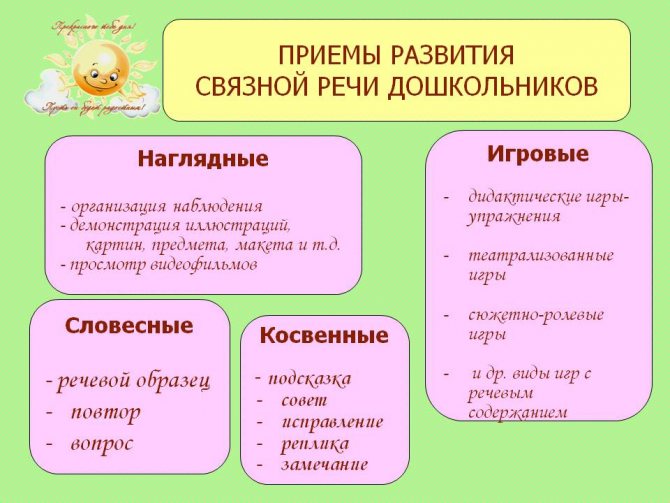
It is important to note that it is the child’s perception of adults’ speech and the development of his own that plays a decisive role in the development of many other cognitive processes of a preschooler.
And if we say that the development of cognitive processes in both primary and senior preschool age is largely determined by speech, this will not be an exaggeration. It is through clarification, explanation, correction that an adult has the opportunity to direct their development. And also receive “feedback” from the child, assessing how effectively the training is going.
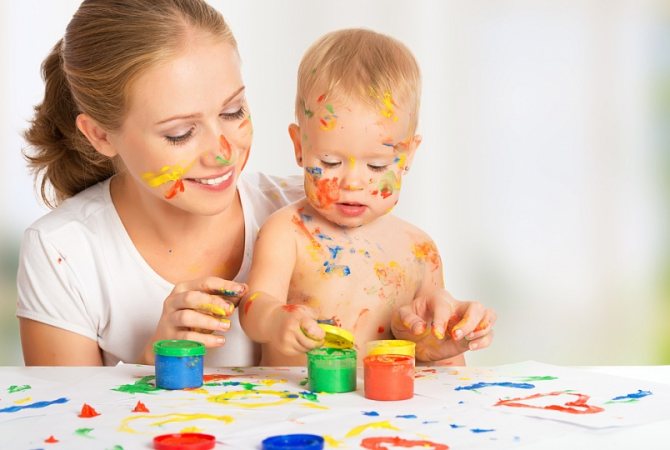
The more you work with children, the faster they develop
The general characteristics of the development of cognitive processes in preschool age are as follows:
- The preschooler's perception of objects in the surrounding world becomes more developed; the child no longer just takes a quick glance at them, but tries to carefully examine them, peering into the details.
- Observing objects and phenomena, the child tries to establish cause-and-effect relationships and learn their properties.
- Thanks to an increase in memory capacity, a preschooler is already able to remember the plots of fairy tales and learn short poems by heart.
- Speech can be used not only to communicate with others, but also to control one’s behavior.
- The child begins to listen to the instructions of adults and follow the instructions given by them.
- Imagination becomes more developed; the child begins to clearly distinguish between reality and fiction, truth and lies.
leave a comment
The importance of entertaining material in the development of cognitive activity of preschool children
Any logical ingenuity task, no matter what age it is designed for, involves a certain mental load, which is often masked by an entertaining plot, external data, the conditions of the task, and so on. The mental challenge of creating or modifying a character, finding a solution, guessing a number is playfully translated into game actions. Ingenuity, resourcefulness, and initiative are manifested in active mental activity based on direct interest.
The variety of entertaining material - games, tasks, puzzles - serves as the basis for their classification, although it is quite difficult to classify such diverse material created by mathematicians, teachers and methodologists into groups. It can be classified according to several criteria: content and meaning, the nature of mental operations, as well as the focus on developing certain skills.
Based on the logic of the actions performed by the person who solves the problem, a variety of entertainment material can be classified into 3 main groups: Fun, mathematical games and tasks, educational (didactic) games and exercises. The basis for the classification of these groups is the nature and purpose of the material of one type or another.
Of all the variety of entertaining mathematical material in preschool age, didactic games are the most common. Their main goal is exercises in discrimination, identification, naming the number of objects, numbers, geometric shapes, directions, etc. Didactic games have the opportunity to form new knowledge and introduce children to the possibilities of action. Each game solves a specific problem of improving children’s mathematical (quantitative, spatial, temporal) concepts [6, p.83].
Didactic games are included in the training content as one of the means of implementing program tasks. The place of a didactic game in the structure of a lesson on the formation of elementary mathematical concepts is determined by the age of the children, the purpose, task and content of the lesson. It can be used as a learning task, an exercise, to complete a specific concept formation task.
Didactic games and game exercises with mathematical content are the most well-known and frequently used types of entertaining mathematical material in modern preschool education practice. In the process of teaching preschoolers, mathematical games take a direct part in learning, being a means of forming new knowledge, expanding, clarifying, and consolidating educational material.
In an integrated approach to the formation and education of preschool children in modern practice, an important role belongs to entertaining and educational games, tasks, and entertainment. They are interesting for children and emotionally captivating. And the process of solving, finding an answer based on interest in the problem is impossible without the active work of the mind. This situation explains the importance of exciting tasks for the mental and all-round development of children. Through games and exercises with exciting mathematical material, children acquire the ability to independently find solutions. Systematic practice of solving problems in this way develops mental activity, independent thinking, a creative attitude to a learning task, and initiative [19, p. 125].
Activating the cognitive activity of preschoolers is unthinkable without the use of entertaining games, tasks, and entertainment. Thus, the role of simple entertainment material is determined taking into account the age capabilities of children and the tasks of comprehensive development and education:
- activate their mental activity,
- stimulate their intellectual activity and interest in the subject,
- exciting and interesting,
- develop your mind, expand and deepen your understanding,
- consolidate acquired knowledge and skills, practice them in other activities and new conditions.
